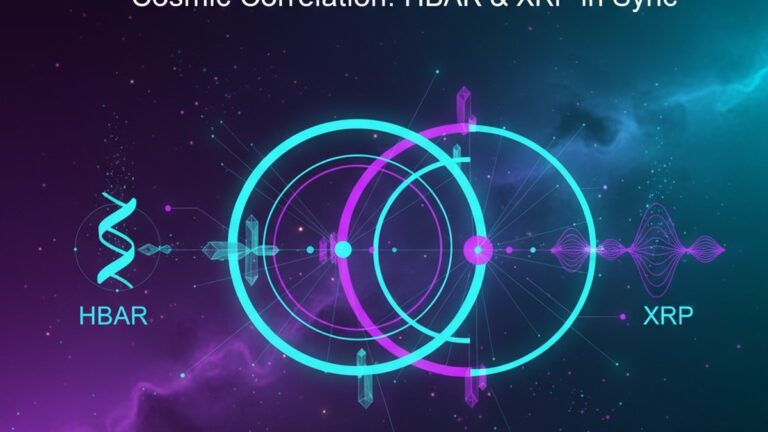In the ever-dynamic world of cryptocurrency, correlations between digital assets often provide intriguing insights into future price trajectories. A relationship that has caught the eye of analysts and investors alike is the near lockstep movement of Hedera Hashgraph’s HBAR and Ripple’s XRP. As both cryptocurrencies exhibit potential for bullish breakouts and sustained growth, market participants are keenly assessing their respective tokenomics, partnerships, and ecosystem developments to gauge which might outperform in 2025.
The Correlation Conundrum
The parallel movement between HBAR and XRP provides an interesting case study for market watchers. The two assets, while fundamentally different in their technological approaches and use cases, have demonstrated a strong correlation in price movements over recent months. This phenomenon has led to speculation regarding the underlying factors driving this synchronicity.
One possible explanation lies in the broader market dynamics, where macroeconomic factors and investor sentiment often impact a wide range of assets simultaneously. Nevertheless, the consistent correlation suggests there might be more at play, potentially linked to shared investor demographics or overlapping use cases in the financial technology sphere.
Analyzing Tokenomics
When comparing HBAR and XRP, tokenomics is a critical factor that investors are considering. HBAR, the native token of the Hedera Hashgraph network, is based on a unique proof-of-stake model that emphasizes speed and security. With a total supply cap of 50 billion tokens, HBAR’s distribution and inflation mechanisms are designed to incentivize network participation and stability.
In contrast, XRP, utilized within the Ripple ecosystem, operates on a consensus ledger protocol. Its total supply of 100 billion tokens was pre-mined, and a significant portion is held in escrow by Ripple Labs, which releases a predetermined amount into circulation each month. This controlled release aims to manage liquidity and mitigate excessive volatility.
Both assets have their strengths, with HBAR’s model appealing to those who prioritize decentralization and security, while XRP’s structured release strategy offers predictability and potentially reduces sudden market shocks.
The Power of Partnerships
Partnerships play a pivotal role in the growth prospects of both HBAR and XRP. Hedera Hashgraph has made significant strides by forming alliances with industry giants like Google, IBM, and Boeing. These collaborations not only bolster Hedera’s credibility but also expand its reach across various sectors, from supply chain management to digital identity solutions.
XRP, meanwhile, benefits from Ripple’s extensive network of financial institutions and payment providers. Ripple’s partnerships with banks and payment processors worldwide underscore its focus on facilitating cross-border transactions. This strategic positioning could prove advantageous as the demand for efficient, low-cost international payments continues to rise.
Ecosystem Expansion
The ecosystems surrounding HBAR and XRP are rapidly evolving, contributing to their long-term potential. Hedera’s development community is actively building decentralized applications (dApps) that leverage its high throughput and low transaction costs. From tokenized assets to decentralized finance (DeFi) solutions, the variety of projects on Hedera’s platform is steadily growing.
Similarly, XRP’s ecosystem is expanding through initiatives like RippleNet and the XRP Ledger’s support for smart contracts. These developments aim to enhance the functionality and versatility of the XRP network, attracting developers and enterprises seeking reliable blockchain solutions.
Weighing the Prospects
As we look toward the future, the correlation between HBAR and XRP continues to spark debates among investors and analysts. Some argue that HBAR’s innovative technology and strategic partnerships position it as a strong contender for significant growth. Its focus on enterprise solutions and commitment to sustainability resonate with a growing number of organizations seeking scalable blockchain solutions.
On the other hand, XRP’s established presence in the financial sector and its ongoing efforts to navigate regulatory challenges could give it an edge in achieving widespread adoption. Ripple’s proactive approach to legal matters, particularly its efforts to clarify XRP’s status as a digital asset, may ultimately foster greater confidence among traditional financial institutions.
Conclusion: A Balanced Outlook
In conclusion, the HBAR-XRP correlation offers a fascinating glimpse into the complex interplay of factors influencing cryptocurrency markets. Both assets exhibit promising attributes, though their paths to growth may differ. For investors, the decision to invest in HBAR, XRP, or both may hinge on individual risk tolerance, market outlook, and belief in each asset’s unique value proposition.
As we move further into 2025, the crypto landscape will undoubtedly continue to evolve, with HBAR and XRP poised to play significant roles in shaping the future of digital finance. Whether these assets move in tandem or diverge, their journeys will be closely watched by those eager to capitalize on the next wave of blockchain innovation.

Steve Gregory is a lawyer in the United States who specializes in licensing for cryptocurrency companies and products. Steve began his career as an attorney in 2015 but made the switch to working in cryptocurrency full time shortly after joining the original team at Gemini Trust Company, an early cryptocurrency exchange based in New York City. Steve then joined CEX.io and was able to launch their regulated US-based cryptocurrency. Steve then went on to become the CEO at currency.com when he ran for four years and was able to lead currency.com to being fully acquired in 2025.


